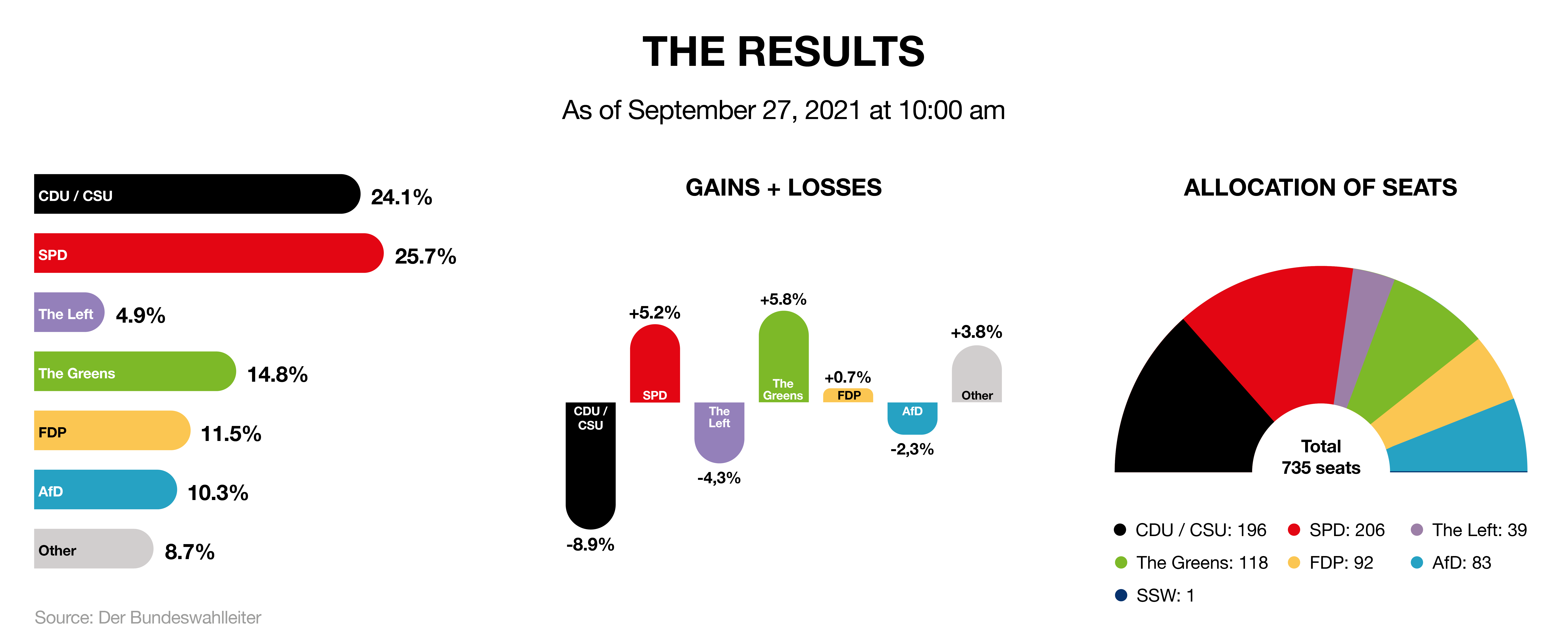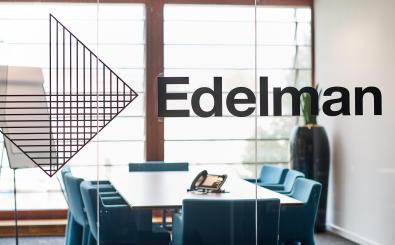The German parliamentary election was extremely close. The Social Democrats won narrowly ahead of the Conservatives. As no coalition option exists without major hurdles, it is currently unclear who will be successful in claiming leadership and form the incoming government.
Given the historically close and ambiguous election results, at a turning point after 16 years of Angela Merkel and at the start of the post-COVID-19 phase and facing the historical tasks of climate change: this Bundestag election is of outstanding importance – for Germany and Europe.

Your Takeaways
- The End of the People’s Parties in Germany: Party ties dissolve strongly, and parties equalize in strength: The days of two major parties taking turns determining the government are over. Thus, majorities are harder to organize - both government formation and governing itself are becoming more complex. Interest groups from all political and economic spectrums try to exert influence. Stakeholder landscapes are becoming increasingly fragmented.
- More challenges ahead: How to handle green transition, restructuring state finances, implement digitization, and “Build Back Better” after COVID-19? The upcoming government will face huge economic and social challenges. While the great coalition combined conservative and social democratic politics causing many conflicts for 8 years, today we might see tougher conflicts around bigger challenges.
- A weak chancellor: Merkel strengthened the chancellor’s office with her leadership style during her 16 years in office. Given the weak position of the new chancellor, it is questionable whether he can do the same. Firstly, 3/4 of the voters did not elect the new chancellor. Secondly, he will experience greater challenges in terms of power politics; on the one hand, given the opposition he will face from within the party. On the other hand, given that the two potential junior partners have emerged stronger from these elections.
- Germany is going green: With a high likelihood of the Greens participating in a government, climate protection will be even more at the forefront. However, the other parties are also attempting to score points on the issue, which illustrates the influence of the Greens on setting the agenda. A cross-party climate policy will be part of a “Build Back Better” course after COVID-19. All in all, a mix of promoting innovation and stronger regulations can be expected.
- The Social Democrats: The surprising and expected winner: Surprising, since Scholz pulled the party out of years of polling lows and benefited from the slip-ups of his opponents. Expected, since he brought his lead of to the finish line by positioning himself as Merkel’s heir and partly copied her style. As the SPD also won two same-day state-elections, Scholz and his party can be seen as the election’s winner. We’re going to see an internal battle over the future direction of the SPD: While Scholz is a man of the center, many are calling for a left-wing course.
- The Conservatives: The Conservatives suffer a historic defeat. It is their worst election result ever. A weak candidate, a muddled campaign, a lack of party unity and one laugh costs the expected secure victory. Furthermore, the Conservatives lost crashing on federal level too. Despite the defeat, Laschet will try to form a government to save his political career. But it is uncertain whether he can hold on as CDU-party chairman. If not, fierce, internal power struggles for leadership are to be expected.
- The Greens: Winner, but loser - compared to 2017, the Greens have nearly doubled their election result. But several own mistakes and some anti-Green campaigns made them lose their momentum and cost the presumed chancellorship. Yet, it is highly likely that the Greens will be part of the next government. They find themselves in the role of kingmakers. As a partner in any coalition, the Greens will claim a super climate and environment ministry. After Baerbocks defeat, however, it is unclear whether she will be able to maintain her leading position or make way for co-chair Habeck.
- The Liberals: The Liberals are kingmakers, too. The party has made gains, reaching double digits for the second time in a row in a federal election. Their mission is clear after blowing up coalition talks 4 years ago: Entering the coming federal government. Above all, they want to implement their fiscal and economic policy goals. The party’s strong man Lindner prefers a coalition with the conservatives, eyeing the contested finance ministry. Likely he continues to unite the party behind him, however difficult coalition talks may become.
- The Leftist: The Leftist win three direct mandates and therefore enters the parliament with a full parliamentary group - even if they fail to pass the five-percent hurdle. The poor result is a defeat and prevents a red-green-red coalition option. The party was unable to offer its voters a clear profile due to internal disputes over direction - and the fact that the Leftists could not take responsibility or counter-positions in handling Covid-19.
- The Far-Right AfD: The AfD has suffered a minimal loss but established itself as the sixth force in the German party landscape – particularly in eastern Germany. Neither the fact that the AfD is becoming increasingly radicalised nor several scandals around financing deterred their core voters. Founded as an anti-euro party, they have gained profile through their anti-migrant sentiment. Most recently, they joined protests on COVID-19 protections.
Coalition scenarios
Voters have not given any party a clear mandate to govern. These historically ambiguous election results can lead to several scenarios for a governing coalition. While some coalitions are clearly more likely than others, the formation of the next government is going to be suspenseful. It now comes down to the parties’ skill in building coalitions.
Who is the better negotiator?
In any case, both the Greens and the Liberals are kingmakers and were the first to announce that they were willing to talk, to explore commonalities and shared goals. Although a difficult process of formation of a government is on the horizon, all parties have said they want to avoid a lengthy 5-month process like in 2017 and reach an agreement by the end of the year.
A majority government can be formed from 368 seats.
Social Democrats, Greens, Liberals

The so called “traffic light” coalition would end the conservative’s 16-year reign. While Social Democrats and Greens are mostly keen to start the social-eco-liberal government, the Liberals (preferring a conservative coalition) are expected to hesitate. In contrast to 2017, they now want to govern. The parties overlap particularly on the issues of digitization and a stronger EU. However, they disagree on central issues such as climate protection and tax increases. Despite these differences this coalition would be the only one representing all of the election’s winners – and therefore most closely represent the sentiment of the German political mood in 2021.
Conservatives, Greens, Liberals

Traditionally, the election winner leads coalition negotiations with potential partners. Nevertheless, the conservatives also want to lead a government what is not entirely unlikely. After all, the FDP prefers a coalition with the conservatives. Lindner has a close bond with Laschet because the two governed on state level. The Green party base prefers a coalition with the Social Democrats – while there are also important proponents for a “Jamaica” government (like Habeck). “Jamaica” would also allow the greens to leave the shadow of the SPD, as the “eternal” No. 2 in the center-left camp.
Social Democrats, Conservatives, Greens

Similar constellations already exist at the state level. This coalition would have a large majority in parliament and gain legitimacy as it would include the Greens and their momentum. There would be no real role for the opposition in the upcoming years. The reasons why this coalition is unlikely are the same as for a coalition with the Liberals instead of the Greens - the Conservatives would probably not go along with this step, especially the Bavarian CSU. It will only be a last resort if other preferred solutions are not working out. If this coalition does come about, the biggest changes will be in climate policy.
Social Democrats, Conservatives, Liberals

In the TV debates, CDU/CSU candidate Laschet did not rule out joining an SPD-led coalition as a junior partner. But he would have difficulties getting the party to support such a coalition. This approach would likely be highly complicated with regards to set-up and realization, and remains an unlikely solution. In addition, there is no immediate need to get a third coalition partner on board if Social Democrats and Conservatives would work together.
Social Democrats, Conservatives

Another so-called Grand Coalition (GroKo) but this time under SPD leadership? Many voters are GroKo-weary after so many years and want a political change. Moreover, such an alliance would likely be a last-resort option, if no other coalition is formed and to prevent new elections, if necessary. What would this mean politically? It would mean, “carry on as before” – a total contrast to the momentum of the election night.
Next Steps
- Initial Reactions: In the first days, we’ll see many special party meetings and conflicting analyses, strategic planning and tactical statements of intent.
- Exploratory Talks: Who can imagine forming a coalition with whom and under what conditions? As there are several coalition scenarios, there might be several exploratory talks – some might be started for the sole reason of building pressure on other talks.
- Coalition Negotiations: Once parties have agreed to work together in government, coalition negotiations begin. As there are not only various coalition scenarios, but – within these – also various interests of several parties, these might be lengthy negotiations that also could fail. The negotiations are finalized with a coalition treaty that is confirmed by each party.
- Election & Appointment: The new chancellor is elected by the new parliament and appointed by the Federal President. This is the start of the new government.
- Formation of New Government: Following the negotiated departmental distribution, the ministers are sworn. Pratical government work begins.
There is no time limit for forming a government. The longest formation by far (in 2017) lasted almost half a year. In that phase, the previous government remains in office on a caretaker basis. Given the complexity of the situation, it is quite possible that we will not have a fixed government by the end of the year.



